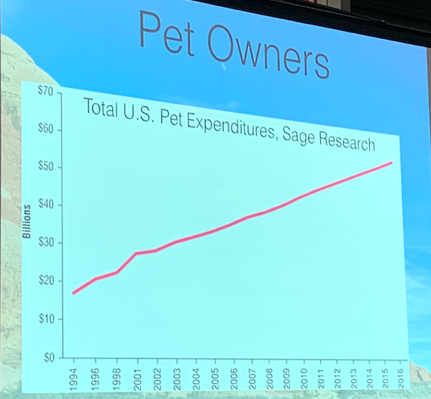Fetch 2018: Navigating Industry Changes to Achieve Success
During the 2018 Fetch conference, veterinary consultant Bash Halow, CVPM, LVT, provided expert advice on how practices can embrace the industry's changing landscape and use emerging trends to their advantage.

It's easy to regard the rapidly changing landscape of the veterinary industry in a negative light, admitted Bash Halow, CVPM, LVT, a veterinary practice consultant who spoke at the 2018 Fetch conference in San Diego. However, the ongoing transformation offers many advantages, especially for private veterinary practices that are small and nimble enough to change.
Throughout his lecture, Mr. Halow challenged attendees—and all veterinary practice owners—to reflect on what their practices are doing well and how they can build on those attributes to become even more competitive in the future. It is also important, he said, to pinpoint areas that are lacking and consider that they may be signs that a practice is stagnating.
Recognizing the Highs and Lows of the Industry
It is well known that today’s pet owners think of their pets as family. In fact, recent survey data show that 90% of pet owners regard their pets as family members, 60% love their current pet more than their childhood pet, and 94% buy their pets presents during the holidays. These are important statistics for veterinary practices to keep in mind as they market products and add-ons to clients.
Mr. Halow also pointed to recent data from Capstone Research that highlighted the upward trajectory of the industry. “The pet and animal care industry has seen volume acquisition rise in the past 5 years and reach record levels because of growing pet humanization trends,” he explained. “As a result, natural pet foods, using technology to better connect with one’s pet, and veterinary and health-related services are all subsegments that have seen heightened growth in the industry.”

Even during times of nationwide turmoil, such as the Great Recession, the pet industry continued to flourish and sales have grown steadily year over
year. In 1994, for example, total pet expenditures in the United States were just under $20 billion. Fast forward to 2017 and that number surpassed $60 billion.
Although these figures are positive, Mr. Halow reminded attendees that in many parts of the country the middle class is dwindling. Nationwide, 50% of veterinary clients earn less than $52,000 per year, and more than 40% said they would have trouble producing $400 in cash in an emergency situation,
he said. Additionally, 65% feel the cost of pet supplies and services is too high.
What these data should relay to practice owners and managers is that even though the industry as a whole is flourishing, it is important to keep the demographics of your client base in mind, especially when encouraging team members to make recommendations. In his work consulting with practices around the country, Mr. Halow said it always stood out to him how debilitating it was for a veterinary team to try to upsell clients on services they knew clients could not afford. For example, if you can see that your client has poor dental health, it is very unlikely that they will comply with recommendations to have extensive dental work done on their pet, and even initiating the conversation might be stressful or embarrassing for a veterinary technician.
Utilizing Trends in Technology
Pet owners, like much of the rest of the population, are increasingly interacting with the world through technology. And while Mr. Halow acknowledged that many generalizations are made about millennials, he noted that there are interesting statistics about this influential group that hospitals can learn from. A\ccording to the American Animal Hospital Association, 35% of pet owners are millennials. And as a whole, one-third of millennials make purchases on their laptops, and 55% to 75% shop for coupons prior to making a purchase. In addition to price, Mr. Halow said, millennials are highly influenced by online reviews prior to making a purchase.
How can a practice use this information to its advantage? For starters, Mr. Halow said to consider adding coupons to your clinic’s website for first-time clients. He also explained that when he was in practice, client care representatives were allowed to offer new clients up to 60% off the price of vaccination services if they feel the caller is phone shopping services and is about to hang up and contact a nearby competitor. These tactics, he said, provide staff with an extra tool to incentivize new clients. From there, it is your exceptional veterinary care that will keep them coming back.
Embracing Consolidation
It is a knee-jerk reaction among veterinary professionals to view consolidation as wrecking the industry and ruining the culture. As it turns out, Mr. Halow said, consolidation is a normal trend that happens in all industries. Based on how trends in consolidations historically unfold throughout the United States, he said now is probably one of the best times to sell your practice to a larger company that is focused on consolidation if that is of interest to you and will serve your business and financial needs.
“We are in an unprecedented seller’s market,” he said, “and the median sales price for a veterinary practice is 12.5 times EBITDA (earnings before interest, taxes, depreciation, and amortization), which is basically your adjusted net revenue.” However, this figure is not entirely applicable to small practices. Instead, Mr. Halow explained, a private practice with an annual revenue exceeding $1.5 million with 3 to 5 veterinarians on staff is likely to be offered 6 to 8 times EBITDA. This figure would be higher for practices located in a strategic area or could decrease to the traditional 5 times EBITDA rate for practices earning less than $1.5 million.
Recognizing and Reversing Stagnation
Fewer staff meetings, clutter, and increased tardiness and callouts by team members are all signs of stagnation within a veterinary hospital, Mr. Halow explained. Another clear indicator of stagnation that may be misconstrued, however, is when staff members insist they cannot handle additional work. This is a sign of stagnation within a hospital because the refusal to take on more work actually stems from feeling overwhelmed, but leadership often does not recognize these feelings or the situations that are causing them.

When you expect your staff to multitask, you are asking them to split their attention in 3, 4, or 5 different areas. This increases the likelihood of errors and decreases their chance of success, Mr. Halow explained. “When I look back on my eagerness to get people to multitask, what I was really asking them to do was make my broken system work,” he said. When team members are resistant to take on additional work, it is not because they are lazy. What they are really saying is “don’t make me screw up.” Practice leaders must rethink how they will manage practice growth without placing an undue burden on staff.
One of Mr. Halow’s biggest pieces of advice to combat stagnation is to take the necessary time to revisit what made you passionate about veterinary medicine to begin with and to accept the fact that the main causes of stagnation may be stemming from the way you currently manage the practice. From there, create a mission statement to which your clinic and staff can adhere, and work to create a stronger sense of team in which all departments are working toward a shared goal and can revel in each other’s success.
2 Commerce Drive
Cranbury, NJ 08512
All rights reserved.